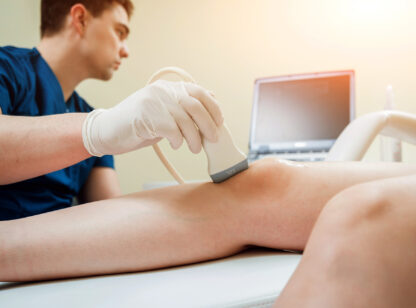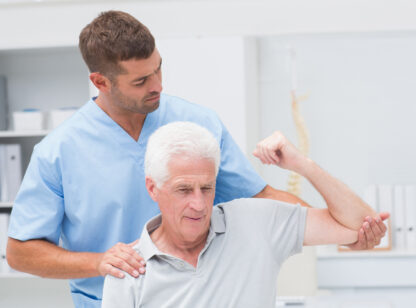Tennis is a fantastic sport. As an orthopedic surgeon, I routinely prescribe exercise to my patients to improve their wellbeing, and I often recommend tennis. Once learned, it is a sport that can be played well into our golden years. However, there are sports injuries that can accompany the game.
Whether you aspire to be center court across from Venus at the BNP Paribas Open or you are a weekend warrior who plays tennis for fun and health, here are three common tennis injuries to watch for:
Tennis Elbow
Tennis elbow is technically known as lateral epicondylitis. It occurs when tendons joining the forearm muscles to the elbow become inflamed on the outside of the elbow. The condition is usually the result of overuse, such as a sudden increase in playing volume, or intense training sessions and long matches. Tennis elbow can occur in other racquet sports like badminton, racquetball or lacrosse, and can even occur in non-athletes.
Symptoms: Patients indicate pain or burning on the outside of the elbow and weakened grip strength. Often, the symptoms are worse when doing activities that require forearm engagement or a strong grip.
Treatment: Non-surgical modalities such as anti-inflammatory medications, bracing, steroid shots and physical therapy are the first course of treatment. This is typically successful in 90% of my cases. In rare instances, surgery is required.
Prevention: Make sure your racquet fits you ergonomically in grip size, weight, and string tension. Have a local tennis pro fit your racquet. Just because a tour pro you admire uses a certain racquet doesn’t mean it is the right one for you. Also, perform stretching and strengthening exercises for your forearm and wrist.
Rotator Cuff Tears
The rotator cuff is part of the muscle structure that allows your arm to rotate in your shoulder. Because of multiple movement planes, the joint is quite complex as it involves a large group of muscles and tendons. The rotator cuff is located underneath the large deltoid muscle of the shoulder and stabilizes this joint. Large tears or micro-tears can occur in these muscles or tendons. A rotator cuff tear can transpire in a single event, such as a huge serve followed by incredible pain. What patients often fail to realize is the tear often materializes more gradually, as the result of overuse and the onset of pain is quite subtle. Thus, they’ll think they don’t have a tear because there was no sudden onset. This is a mistake. With any shoulder pain beyond mild soreness, see an orthopedic specialist or your general physician as the tear can become worse.
Symptoms: Watch for shoulder tenderness, pain, a weakened tennis serve, or “dead arm syndrome,” feeling your arm is just too heavy to lift. At times, a cracking or popping noise may accompany these symptoms. Reaching back to snap your bra or pull a wallet out of your rear pocket often activates the rotator cuff muscles and tendons at the rear of the shoulder, making the tear more evident.
Treatment: Non-surgical treatments that involve NSAIDs or steroid injections coupled with rest often alleviate pain, but most tears cannot heal on their own and require surgery. The good news is that the vast majority of tennis players having surgery are able to return to play.1
Prevention: Playing tennis builds up the muscles in the shoulder, but it doesn’t build up those in the rotator cuff. Consider adopting the rotator cuff strengthening routines long common in the pro ranks. A simple online search will reveal a comprehensive program.
Jumper’s Knee
Tennis requires a great deal of horizontal and lateral movements, but there is also more jumping than players might consider. Jumping and landing during serves and volleys can put excessive strain on the patellar tendon. This is the tendon which attaches the kneecap to the shinbone. Inflammation or microscopic tears occur in the tendon, leading to this persistent condition officially known as patellar tendonitis.
Symptoms: Pain or soreness occurs just under the kneecap. Often, this is accompanied by swelling and the sensation of being warm to the touch. One of the dangers of this injury is that it usually appears as a mild, nagging injury that “is not that bad.” Many tennis players continue to train and compete on it as the symptoms dissipate after a short period of rest. However, this does not allow for full recovery and can lead to a chronic injury that ultimately requires surgery. Do not ignore it.
Treatment: If caught early and before significant damage to the tendon occurs, the RICE principles of rest, ice compression and elevation coupled with anti-inflammatory medication can help. You must not rush back to playing merely because the symptoms disappear. A jumper’s knee strap may be used once the rest period prescribed has ended. If the case has progressed, surgery may be required followed by 6-12 months of rehabilitation.
Prevention: Learn to land properly when jumping. Don’t tuck your hips under you, as this places the shock load on the knee. Learn to let the hips absorb the landing shock. Do strengthening and flexibility exercises not just for your knees but also for the ankles, hip flexors and lower back. Increasing strength and mobility in these areas allows these joints to share the force of landing with the knee.
So keep playing tennis! It’s a sport chock-full of cardiovascular, strength, bone density and joint benefits along with stress reduction. Just make sure you are following a preventative strength and conditioning program that matches the degree of your competitiveness.
Orthopedic surgeon Dr. Sydney Pardino serves as Director of Sports Medicine at the Institute of Clinical Orthopedics and Neurosciences at Desert Regional Medical Center. For more information visit www.cuttingedgeortho.net or call (760) 416.4511.
References: 1) https://www.ncbi.nlm.nih.gov/pubmed/1558235










































Comments (0)